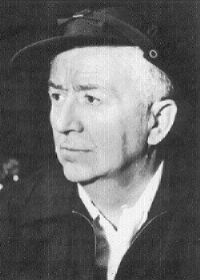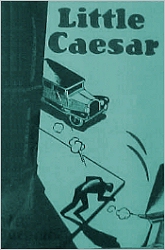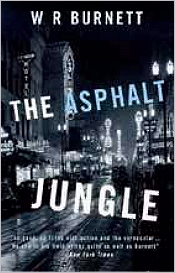 It has been written that if William Riley Burnett's major novels are judged solely for their influence, he was one of the most important writers of his time. His first novel, Little Caesar (1929), about the rise and fall of Rico Caesare Bandello of Chicago's Little Italy, was the prototypical gangster saga. It inspired numerous other writers and Hollywood filmmakers, created a new subgenre, and helped make film legends of Edward G. Robinson, James Cagney, and Humphrey Bogart. Public Enemy (1931), They Live by Night (1948), White Heat (1949), The Godfather (1972)--all are direct descendants of Little Caesar.
It has been written that if William Riley Burnett's major novels are judged solely for their influence, he was one of the most important writers of his time. His first novel, Little Caesar (1929), about the rise and fall of Rico Caesare Bandello of Chicago's Little Italy, was the prototypical gangster saga. It inspired numerous other writers and Hollywood filmmakers, created a new subgenre, and helped make film legends of Edward G. Robinson, James Cagney, and Humphrey Bogart. Public Enemy (1931), They Live by Night (1948), White Heat (1949), The Godfather (1972)--all are direct descendants of Little Caesar.
In addition, Burnett's 1941 classic, High Sierra, added poignant elements of humanity and high tragedy to the gangster story. Similarly, The Asphalt Jungle (1949) and its 1950 film version (Asphalt Jungle) also established a subgenre, that of the "big caper novel," which flourished in the 1950s and 1960s and which still has its proponents and practitioners.
Burnett's novels may fall short of art when judged solely on their literary merits. But as critic George Grella says of Burnett and his work: "He may be the single most successful writer on the notion of the criminal as the emblem of an era. He provides some of the most dynamic and apposite metaphors for the life of America in the twentieth century."
All the first-rank novels by Burnett were written before 1950. In addition to those cited above, others of note include Dark Hazard (1933), Nobody Lives Forever (1943), and two historicals: Saint Johnson (1930), the first substantive novel about Wyatt Earp and the gunfight at the O.K. Corral (as well as the basis for the 1932 film Beast of the City), and The Dark Command (1938). Such post-1950 novels as Vanity Row (1952), Round the Clock at Volari's (1961), and Good-bye Chicago (1981), his last published fiction, are competent but undistinguished. Between 1931 and 1963, Burnett wrote numerous screenplays not only for "A" films such as High Sierra (1941) with John Huston, and This Gun for Hire (1941), with Albert Maltz, but also for lesser "B" movies.
--BILL PRONZINI & JACK ADRIAN, from
Hard-Boiled: American Crime Stories.
 Much gangster lore and rhetoric has to do with the language: threats, blackmail, confessions, tip-offs. Similarly, there is the business of "squealing," "singing," and , indeed, "silencing." Even the rhythms of gangster-speak--quick-fire, staccato--were admirably suited to the fast film stock that had to be used for talking pictures. Add to these factors the sound of screeching tires, police sirens, and volleys of machine gun fire, and it will be understood why Little Caesar was the big hit of 1930.
Much gangster lore and rhetoric has to do with the language: threats, blackmail, confessions, tip-offs. Similarly, there is the business of "squealing," "singing," and , indeed, "silencing." Even the rhythms of gangster-speak--quick-fire, staccato--were admirably suited to the fast film stock that had to be used for talking pictures. Add to these factors the sound of screeching tires, police sirens, and volleys of machine gun fire, and it will be understood why Little Caesar was the big hit of 1930.
Based on a novel by W.R. Burnett, Little Caesar was a lightly disguised biography of Al Capone (Al himself planted a spy on the set while the film was being made). Edward G. Robinson said later of his starring role that it "probably expressed a feeling that millions of people had about their lives." The Depression had indeed made Capone a sort of underdog hero, a challenger of the establishment, a poor boy who made it big, an individualist who lived by his own rules. With Little Caesar--which was swiftly followed by James Cagney in Public Enemy--the gangster movie was reborn, as social comment.
Warner Brothers, the pioneers of sound, had also made a discovery. Dialogue didn't have to sound like dialogue; it didn't have to be Broadway posh or particularly intelligent. "Yeah, yeah, awright, you guys, yeah, yeah" was verse drama to the ears of a 1930s groundling. "I had a literary theory about dialogue," said W.R. Burnett:
This was in the twenties. Novels were all written in a certain way, with literary language and so much description. Well, I dumped all that out; I just threw it away. It was a revolt, a literary revolt. That was my object. I wanted to develop a style of writing based on the way American people spoke--not literary English. Of course, the fact that the Chicago slang was all around me made it easy to pick up.Ultimately what made Little Caesar the enormous success it was, the smack in the face it was, was the fact that it was the world seen completely through the eyes of a gangster. It's a commonplace now, but it had never been done before then. You had crime stories but always seen through the eyes of society. The criminal was just some son-of-a-bitch who'd killed somebody and then you go get 'em. I treated 'em as human beings. Well, what else are they?
 Burnett had an unkind notion (many of Burnett's notions were unkind) that the Warners bought Little Caesar because the hero comes from Youngstown, Ohio: the Warner boys were sons of a Youngstown butcher. It seems more likely that they bought it because Burnett had a priceless knack: he knew how tough guys talked. Later Burnett stories like High Sierra and The Asphalt Jungle are now ranked as film classics rather than as works of printed fiction, but Burnett never minded much about literary critics, or so he claimed. The son of a family of Irish Ohio political bosses, he moved to Chicago in 1927 to "soak up the atmosphere," and took pride in being "among the first at the scene of the St. Valentine's Day Massacre."
Burnett had an unkind notion (many of Burnett's notions were unkind) that the Warners bought Little Caesar because the hero comes from Youngstown, Ohio: the Warner boys were sons of a Youngstown butcher. It seems more likely that they bought it because Burnett had a priceless knack: he knew how tough guys talked. Later Burnett stories like High Sierra and The Asphalt Jungle are now ranked as film classics rather than as works of printed fiction, but Burnett never minded much about literary critics, or so he claimed. The son of a family of Irish Ohio political bosses, he moved to Chicago in 1927 to "soak up the atmosphere," and took pride in being "among the first at the scene of the St. Valentine's Day Massacre."
After the success of Little Caesar, he moved to Hollywood, but he signed no long-term contracts there: he worked on several screenplays--notably Scarface (1932) for Howard Hawks--but his favored method was to write filmable novels and then let other people sweat over the scripts. After all, with any film, the question of authorship is always hard to settle. On the matter of Scarface, for example, people can get quite heated about who was responsible for that film's most celebrated gimmick: the endless tossing of a coin by the character Guino, played by George Raft. In addition to Ben Hecht, no fewer that three writers worked on the picture. Two of them, W.R. Burnett and John Lee Mahin, have had their say on the subject of the coin.
Hawks has claimed credit for the device while Mahin defends Hecht, but then Hecht wrote the script with Hawks, so who can tell? Once an argument about attribution begins, there is almost no point in pursuing it. Burnett recalls: "You know that coing thing in Scarface? It's one of the things that made the damn picture. That was Raft's idea. He realized he wasn't a good actor, which he wasn't. But he knew if he reacted to what other people said, he was effective."
--IAN HAMILTON, from Writers in Hollywood.